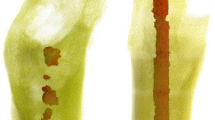Abstract
The aim of this study was to evaluate the histological and radiological osseointegration characteristics of implanted solvent-preserved cancellous bovine bone substitution material Tutobone® after opening-wedge osteotomy and hip arthroplasty in human. The baseline hypothesis connected to the usage of bovine bone substitute materials is the assumption of temporary structural support, integration in the surrounding bone, bioresorption and replacement with vital bone. This hypothesis is based on numerous studies evaluating sintered bovine grafts showing good osseointegration and stability. Studies analyzing cancellous bovine grafts such as Tutobone® hardly exist. The only rabbit defect model showed 100% remodeling of Tutobone® after 26 weeks. However, no histological data are available on application of this xenograft in patients. In this study, nine patients biopsies were collected about 11 months after application of Tutobone®. Unlike animal studies, the results showed incorporated avital graft remnants (47%) as well as new bone formation (53%) of the total mineralized area. Radiological evaluation confirmed increasing signs of osseointegration and an incomplete resorption. In conclusion, degradation and replacement of bovine graft seems to be less accelerated in patients than the animal study indicated. Nevertheless, Tutobone® shows an excellent biocompatibility, good osteoconductive characteristics and may represent a useful alternative to autogenous graft.






Similar content being viewed by others
References
Arrington ED, Smith WJ, Chambers HG, Bucknell AL, Davino NA (1996) Complications of iliac crest bone graft harvesting. Clin Orthop Relat Res 329:300–309
Bloemers FW, Blokhuis TJ, Patka P, Bakker FC, Wippermann BW, Haarman HJ (2003) Autologous bone versus calcium-phosphate ceramics in treatment of experimental bone defects. J Biomed Mater Res B Appl Biomater 66:526–531
Briem D, Linhart W, Lehmann W, Meenen NM, Rueger JM (2002) Long-term outcomes after using porous hydroxyapatite ceramics (Endobon) for surgical management of fractures of the head of the tibia. Unfallchirurg 105:128–133
Diringer H, Braig HR (1989) Infectivity of unconventional viruses in dura mater. Lancet 1:439–440
Gunther KP, Scharf H-P, Pesch H-J, Puhl W (1996) Osteointegration lösungsmittelkonservierter Knochentransplantate im Tiermodell. Osteologie 5:4–12
Gunther KP, Scharf H-P, Puhl W (1998) Osteointegration einer Trikalziumphosphatkeramik und unterschiedlich konservierter Knochentransplantate im Tierexperiment. Hefte zu “der Unfallchirurg”: Biodegradierbare Implantate und Materialien: 265
Hartl A, Bitzan P, Wanivenhaus A, Kotz R (2004) Faster integration of human allograft bone than of the bovine substitute Lubboc: non-randomized evaluation of 20 cases with benign tumors or tumor-like conditions. Acta Orthop Scand 75:217–220
Helber MU, Ulrich C (2000) Metaphyseal defect substitute: hydroxylapatite ceramic. Results of a 3 to 4 year follow-up Unfallchirurg 103:749–753
Levai JP, Bringer O, Descamps S, Boisgard S (2003) Xenograft-related complications after filling valgus open wedge tibial osteotomy defects. Rev Chir Orthop Reparatrice Appar Mot 89:707–711
Morax S, Hurbli T, Smida R (1993) Bovine heterologous bone graft in orbital surgery. Ann Chir Plast Esthet 38:445–450
Pohl S (2004) Konsolidierungsverhalten von xenogener Spongiosa, PhD Dissertation, University of Munich Klinikum rechts der Isar, Department of Trauma Surgery
Rajan GP, Fornaro J, Trentz O, Zellweger R (2006) Cancellous allograft versus autologous bone grafting for repair of comminuted distal radius fractures: a prospective, randomized trial. J Trauma 60:1322–1329
Rueger JM, Linhart W, Sommerfeldt D (1998) Biologic reactions to calcium phosphate ceramic implantations. Results of animal experiments. Orthopade 27:89–95
Sarkar MR, Wachter N, Patka P, Kinzl L (2001) First histological observations on the incorporation of a novel calcium phosphate bone substitute material in human cancellous bone. J Biomed Mater Res 58:329–334
Schenk RK (1991) Zur Problematik der Knochenersatzstoffe: Histophysiologie des Knochenumbaus und der Substitution von Knochenerstazstoffen. Hefte Unfallheilkd 216:23
Schnurer SM, Gopp U, Kuhn KD, Breusch SJ (2003) Bone substitutes. Orthopade 32:2–10
Tadic D, Beckmann F, Donath T, Epple M (2004) Comparison of different methods for the preparation of porous bone substitution materials and structural investigations by synchrotron-computer tomography. Materwiss Werksttech 35:240–244
Thull R, Sturm A, Pesch H-J (1993) Mechanische Eigenschaften nativer und präparierter Spongiosa. In: Pesch HJ, Stöß H, Kummer B (eds) Osteologie aktuell VII. Springer, Heidelberg, pp 157–163
Werber KD, Brauer RB, Weiss W, Becker K (2000) Osseous integration of bovine hydroxyapatite ceramic in metaphyseal bone defects of the distal radius. J Hand Surg [Am] 25:833–841
Author information
Authors and Affiliations
Corresponding author
Additional information
The authors did not receive any financial support for this study.
Rights and permissions
About this article
Cite this article
Meyer, S., Floerkemeier, T. & Windhagen, H. Histological osseointegration of Tutobone®: first results in human. Arch Orthop Trauma Surg 128, 539–544 (2008). https://doi.org/10.1007/s00402-007-0402-z
Received:
Published:
Issue Date:
DOI: https://doi.org/10.1007/s00402-007-0402-z




